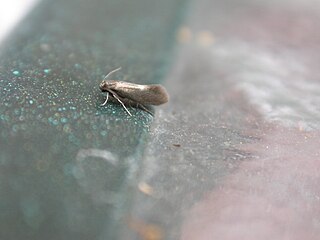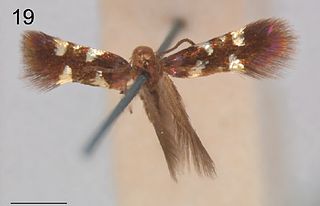Argyresthia eugeniella, the guava moth, is a moth found in Florida.

A family of primitive monotrysian moths in the order Lepidoptera, Heliozelidae are small, metallic day-flying moths with shiny smooth heads. In Europe the small adult moths are seldom noticed as they fly quite early in the spring. The larvae are leaf miners and the vacated leaf mines are distinctive because the larva leaves a large hole at the end.

Dyseriocrania subpurpurella is a diurnal moth from the family Eriocraniidae. It is found in Europe.

Antispila metallella is a moth of the family Heliozelidae. It is found from Scandinavia to the Pyrenees, Alps and Romania and from Great Britain to Russia.

Antispila is a moth genus of the family Heliozelidae. It was described by Jacob Hübner in 1825.
Antispila ampelopsia is a moth of the family Heliozelidae. It was described by Kuroko in 1961. It is found in Japan.
Antispila orbiculella is a moth of the family Heliozelidae. It was described by Kuroko in 1961. It is found in Japan.
Antispila corniella is a moth of the family Heliozelidae. It was described by Kuroko in 1961. It is found in Japan (Kyushu).
Antispila iviella is a moth of the family Heliozelidae. It was described by Kuroko in 1961. It is found in Japan (Yakushima).
Antispila hikosana is a moth of the family Heliozelidae. It was described by Kuroko in 1961. It is found in Japan (Kyushu).
Antispila hydrangifoliella is a moth of the family Heliozelidae. It was described by Kuroko in 1961. It is found in Japan (Kyushu).
Antispila purplella is a moth of the family Heliozelidae. It was described by Kuroko in 1961. It is found in Japan (Kyushu).

Antispila aristarcha is a moth of the family Heliozelidae. It was described by Edward Meyrick in 1916. It is found in India.
Antispila aurirubra is a moth of the family Heliozelidae. It was described by Annette Frances Braun in 1915. It is found in the US state of California.
Antispila cleyerella is a moth of the family Heliozelidae that is endemic to Japan.
Antispila distyliella is a moth of the family Heliozelidae. It is found on the Ryukyu Islands in Japan.
Antispila isorrhythma is a moth of the family Heliozelidae. It was described by Edward Meyrick in 1926. It is found in India.

Holocacista salutans is a moth of the family Heliozelidae. It was described by Edward Meyrick in 1921. It is found in Zimbabwe and the South African provinces of KwaZulu-Natal and Limpopo.
Antispila trypherantis is a moth of the family Heliozelidae. It was described by Edward Meyrick in 1916. It is found in Guyana.
Antispila kunyuensis is a moth of the family Heliozelidae. It is found in China.




